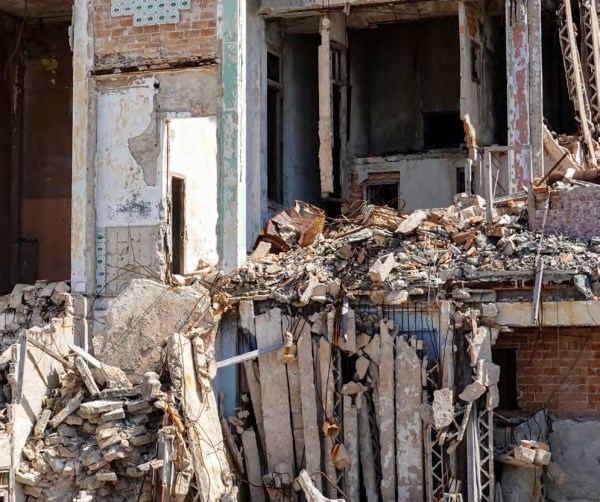Could The Miami Tower Collapse Have Been Avoided?

An Original 2021 Essay by Clare Warburton
At 1:25am on Monday June 24th 2021, 98 people lost their lives when the Champlain Towers South in Miami partially collapsed.
The incident has been considered one of the worst building collapses in recent U.S. history (Delatte, 2021) and one that has made many people aware of the importance of the core building structure, and what implications can arise when an asset of the building anatomy is not attended to within a specified timeframe. There has not yet been any definitive cause for the collapse. Some experts believe it was salt corrosion, being built on a wetland or the construction of a building next door (Oswald & Moore, 2021). However, an engineer’s report from 2018 shows that there was significant structural damage throughout the building that should have been rectified sooner than it was planned for.
“We look forward to working with you in maintaining the structural integrity of the Champlain Towers South Condominium” (Morabito, 2018), was the closing line in the engineer’s report that was sent in an email on October 8, 2018, from Morabito Consultants. Ironic, huh? Whilst the report had numerous items regarding the structural integrity of the building needing to be addressed, Morabito Consultants failed to mention that they were urgent repairs, only that they needed to be “repaired in a timely fashion” (Morabito, 2018). As you analyse the report and delve deeper, you can start to see how the building construction and maintenance may have been the main cause of the disaster.
Throughout the parking garage levels, the engineer’s report found that there was abundant cracking in the concrete columns, beams, and walls, along with large spalls in the topside of the entrance drive ramp and the underside of the pool and entrance drive. Along with that, there is mention that failed waterproofing was causing structural damage to the concrete slab below the entrance drive and the pool deck, due to the waterproofing being laid on a flat structure, not sloped. This is a huge oversight from the developers, and something that comes with substantial costs to repair.
The engineer’s report was completed in October 2018, two and a half years before the incident occurred. In that time, the structural repairs that were noted in the report would have worn down even further and spread throughout the building over time. Not only did the complex have just $777,000 in their Reserve Fund but repairing a complex with 43 listed structural issues is not going to come with a small price tag. In fact, the total cost to repair all structural items, façade, electrical, mechanical, plumbing and sprinkler remediations came to a cost of $9,128,433.60 (Morabito, 2018). The cost to repair the structural issues, which included repaving the plaza/pool area, crack stitching repairs and to create a sloped surface, was estimated at almost $4,000,000 (Morabito, 2018). Repairs began on the complex in the beginning of 2021, after the board finally approved a plan to pay for the work over a space of 15 years that would cost the owners between $80,000 to $336,000.
Whilst some owners may not see the point in establishing a Reserve Fund, this incident and lack of funds to fix, is a clear example that it needs to be established for all schemes, no matter the size of the complex and funds need to be going into the account yearly so that Strata Councils and Owners are prepared for even the smallest of structural issues that could arise.
A Reserve Fund Study in the United States of America is the equivalent of the 10-Year Plan that we have established as a legal requirement for any schemes over 10 lots or that have more than $5,000,000 as their Building Replacement Value. The Study is completed every 5 years and is in place to determine how much money a condominium corporation should have in its Reserve Fund, to ensure that repairs can be paid for in future.
The Study differs from state to state across the US, some have no regulations on reserve funds, some states like California and Hawaii are legally required to do reserve studies, and some say that the Condominium boards must follow some regulations on reserves. Which is where Florida fits in. The Florida law is that “Florida statute does not require a reserve study but requires a reserve schedule for repair and replacement of major components” (Community Associations Institute, n.d).
After the collapse of the Champlain Towers South, laws should be revised to ensure that all states must have a Reserve Fund Study completed, which in turn, will make more owners aware of what needs to be repaired in their building, and to see the structure from an engineer’s point of view.
Whilst there are many theories as to why the building collapsed, the structural issues that were reported cannot be ignored, and the amount of time that it took to commence the repairs. From a Strata point of view, it has taught owners the importance of establishing a reserve fund, so that when any structural issues arise, they can be fixed as soon as possible, and that 10-Year Plans are imperative to make owners and potential buyers aware of issues in their building. If the condominium had the full amount in their Reserve Fund that was needed and attended to the items straight away, could the collapse have been avoided?
REFERENCES
Delatte, N. (2021, June 29). Florida condo collapse – searching for answers about what went wrong in Surfside can improve building regulation. The Conversation. theconversation.com/florida-condo-collapse-searching-foranswers-about-what-went-wrong-in-surfside-can-improvebuilding-regulation-163469
Morabito, F., 2021. CTS – Revised Reports and Estimates. [email].
Community Associations Institute. (n.d.). Reserve Fund Requirements and Funding. caionline.org/Advocacy/Priorities/ReserveStudy/Pages/default.aspx#F
Oswald, D. & Moore, T. (2021, June 25). Why did the Miami apartment building collapse? And are others in danger? The Conversation. theconversation.com/why-did-the-miami-apartment-building-collapse-and-are-others-in-danger-163425
View Comments
(0)